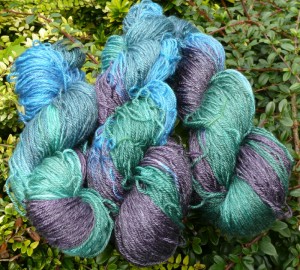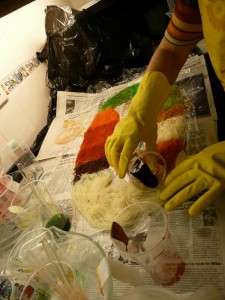While my parents were staying down here, Mummy and I took the opportunity to have another little dyeing day.
We mixed up a whole load of 1% stock solutions (5ml dye powder, 15ml citric acid, and filled up to 500ml with water) of the new colours of Jacquard acid dyes I had bought. 2 pint milk containers (properly labelled of course!) make great receptacles for stock solutions – and they pour quite well too.
You can see the stock solutions all lined up along the back of the worktop below.
We each dyed 4 skeins of yarn this time. It was surprisingly time consuming making up all the stock solutions, and by the time we got to the 4th skein we were both quite tired. I think you can tell that from how my last one came out!
We were both using yarns from H W Hammand again. I dyed 4 skeins of 4ply weight 80% superwash merino, 20% bamboo (a lovely feeling yarn – I am really looking forward to knitting with it). Mummy dyed 2 skeins of DK weight Bluefaced Leicester, and 2 skeins of aran weight, 80% alpaca, 20% silk.
Here is an action shot of Mummy dyeing one of her skeins of DK. She was so active that my camera has blurred her yarn-squashing hand 🙂
I’m afraid I have totally failed to take any photos of Mummy’s yarn once it was finished, so you will have to put up with just mine 🙂
First up, two skeins the same (or as close as I could get it). Here I was experimenting with diluting the dyes to get paler colours.
You may notice that these are a little less bright than colours I usually go for 🙂 This is going to be a Baby Surprise Jacket for a friend who is expecting. I am hoping that it is a good unisex colour and also a colour that hopefully both parents will like. I had better get a move on with the actual knitting!
Just in case you were concerned that I may have become subtle in my old age I bring you exhibit B:
This is going to be socks for me 🙂 I love how cheerful and happy this colour is.
One of the interesting things that happend while dyeing this yarn was that the emerald green dye separated a bit and the turquoise blobs in this yarn actually came from the green. Although I like it in this yarn I’m not sure I would always want that to happen. I was wondering whether I have got the acidity right – I’m sure I read somewhere about dyes separating when the conditions were too acidic. So I have bought some indicator papers and am going to make up a solution with 15ml of citric acid and 500ml of water (which is what I usually add my dye to – but if I tested the actual dye solution the colour would obscure the colour change of the indicator paper) and test out the pH. I am rather looking forward to this actually, somehow more fun than A-level chemistry ever was.
My last experiment wasn’t quite so successful. I hadn’t realised we would have time to dye a 4th skein, so while I had been having a think about the other colours for quite a while, the last one was a bit spur-of-the-moment. I was aiming for a kind of reddy brown, but it turned out that the red we had was on the pink side and the brown was a bit paler and greyer, and not as rich, as I had been expecting.
It isn’t a total disaster, but is not quite what I was after, and I’m not sure that the colour is very me. Luckily Mummy really likes it, so she is going to have it for Christmas (hooray – one down on the Christmas present decisions!).
It was fun using a slightly different base yarn, and the alpaca / silk that Mummy dyed was absolutely gorgeously squishy too. I like how the dyes have come out on the merino / bamboo better than how they did on the merino / tencel. I am looking forward to doing some more experimenting soon.



























